
Economic Affairs, Vol. 65, No. 2, pp. 255-260, June 2020
DOI: 10.46852/0424-2513.2.2020.18

Variability and Growth in Production of Wheat in India
ABSTRACT
Wheat is one of the most popular staple foods in India which compete well with other cereal in nutritive value. Hence based on importance of the crop, the present study examined the performance of wheat production in the country in terms of variability and growth using secondary data for the period of 2000-01 to 2017-18. Variability of wheat in the area, production and productivity was found to be 6.81, 13.87 and 8.10 per cent, respectively for India. The results showed that maximum relative change in area, production and productivity of wheat was noticed in Madhya Pradesh state with 65.97, 226.32 and 96.62 per cent, respectively. Growth in area, production and productivity of wheat crop in India has been increased with positive and highly significant rate of 1.21, 2.46 and 1.23 per cent per annum, respectively. Madhya Pradesh showed highly significant compound growth rates in area, production and productivity with 3.49, 8.21 and 4.56 per cent per annum, respectively. The highest growth in area, production and productivity of wheat in Madhya Pradesh helps in confirming Krishi Karman Award for last five consecutive years. Decomposition analysis indicated that yield contribution in the production of wheat in India was positive and significant with 47.3 per cent followed by area effect of 44.38 per cent whereas interaction effect was found to be 8.31 per cent only revealing that increased productivity is a major factor towards increased production of wheat in India.
Highlights
 The highest growth in area, production, productivity of wheat was found in Madhya Pradesh.
The highest growth in area, production, productivity of wheat was found in Madhya Pradesh.
Keywords: Compound growth rate, decomposition analysis, variability, Krishi Karman Award, production
Wheat is one of the most popular and staple food in India among both vegetarians and non-vegetarians. It compares well with other cereal in nutritive value. It has good nutrition profile with 12.1 per cent protein, 1.8 per cent lipids, 1.8 per cent ash, 2.0 per cent educing sugar, 6.7 per cent pentose, 59.2 per cent starch with good source of mineral of vitamin and nicotinic acid (Agam et al. 2017). It processed in different forms like flour, suzi, maida and being eaten by number of consumers in different ways as porridge (Halwa), chapati, bread and biscuits etc. Besides that, wheat straw and wheat bran are also good source of feed for animals (Yadav et al. 2014). India is the second largest producer of wheat in the world, averaging an annual production of 997 lakh tons (FAO Trade Statistics, 2018). India almost exclusively raises winter wheat. Wheat is mainly grown in the Rabi season (October-December to March-May) along with Barley, Lentils, Peas, Mustard and Potatoes. The sowing of winter wheat starts from 1st of October and runs through to the end of December. Wheat is usually begun to head in January, with the harvest following in March, April and May (Tripathi & Mishra, 2017). Farmer faces the problems in wheat cultivation due to poor resource base and non-adoption of recommended techniques (Ahirwar et al. 2015).
How to cite this article: Sahu, A., Nahatkar, S. and Kolar, P. (2020). Variability and growth in production of wheat in India. Economic Affairs, 65(2): 255-260.
Source of Support: None; Conflict of Interest: None
In the world, India stands at first position in wheat area with share of 12.4 per cent to the total area and in production it occupies second position next to China with 11.5 per cent share and this position is continues for more than a decade (FAO Trade Statistics, 2018). In India total wheat area was accounted for 296.51 lakh ha with production of 998.70 lakh tons with average yield of 3368 kg/ ha. Highest share in area was contributed by Uttar Pradesh state with 32.89 per cent followed by Madhya Pradesh with 17.92 per cent. In production highest share was contributed by Uttar Pradesh with 31.92 per cent followed by Punjab with 17.85 per cent. Among all the states of the country, Uttar Pradesh, Madhya Pradesh, Punjab, Rajasthan and Haryana are the major wheat growing states, which covers around 80% of area and 87% of production of wheat in the country (Directorate of Economics & Statistics, 2017-18).
India is the largest producer and consumer of wheat in the world and therefore there is a need to increase the production of wheat crop so that, it can be exported to other countries and thereby reducing the deficit of balance of payments and also to further boost the economy of a nation. Besides this wheat crop is an important component of buffer stock of the country and livelihood food security mainly depends on this crop. Therefore, keeping in view the importance of wheat crop, the present study was undertaken with following specific objectives:
MATERIALS AND METHODS
The present study was undertaken in all the major wheat producing states such as Uttar Pradesh, Madhya Pradesh, Punjab, Rajasthan and Haryana. The study was mainly based on time series secondary data on wheat area, production and productivity pertains to last 18 years i.e. 2000-01 to 2017-18 for selected states. The data were collected from the published source of Directorate of Economics & Statistics, Ministry of Agriculture web site. Suitable tools viz; Compound growth rate, decomposition model and coefficient of variation were applied for the study. The details of methods of analysis using following statistical and econometrical models are presented as under.
Relative change
This tool explains comparative change among the components of wheat production while, absolute change does not explain this change. Hence the relative change in the area, production and productivity of wheat of different states were analysed using following formula,
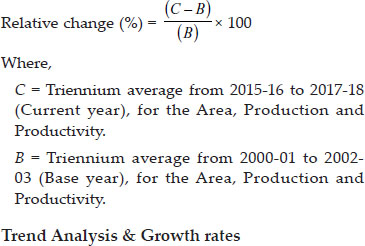
(a) Trend
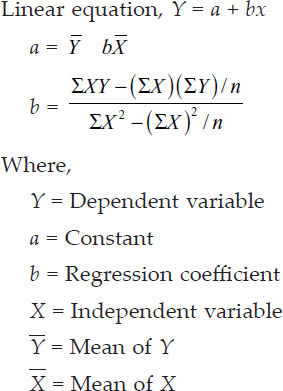
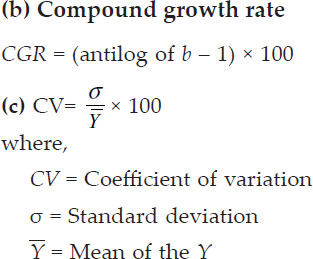
Decomposition model
This model was used for estimation of contribution of area, yield and their interaction towards (increase /decrease) change in production of wheat, as model suggested by many researchers.
Area effect: shows percentage share of area in the total production.

Yield effect: shows percentage share of yield in the total production.

Interaction effect: shows percentage share of area and yield in the total production.

Where,
At, Pt and Yt = Triennium average from 2015-16 to
2017-18 (Current year), for the Area, Production and Productivity
A0, P0 and Y0 = Triennium average from 2000-01 to 2002-03 (Base year), for the Area, Production and Productivity
RESULTS AND DISCUSSION
Wheat Production in India
Wheat production is confined mainly to the northern and central part of India such as Haryana, Punjab, Rajasthan, Madhya Pradesh and Uttar Pradesh which covers around 80 per cent of area and 87 per cent of production of wheat in the country. To a limited extent it is also grown in Bihar, Gujarat and Maharashtra. The data presented in table 1 reveals that the area, production and productivity of wheat crop in India have been increased by 17.58, 39.60 and 18.73 per cent, respectively from its base year (T1) to current year (T2). The maximum relative change in area, production and productivity of wheat was noticed in Madhya Pradesh state with 65.97, 226.32 and 96.62 per cent, respectively. Rajasthan secured second position next to Madhya Pradesh with relative change 36.75, 67.86 and 22.75 per cent of area, production and productivity of wheat, respectively. However, Haryana, Punjab and Uttar Pradesh were also showing positive relative change in area, production and productivity of wheat.
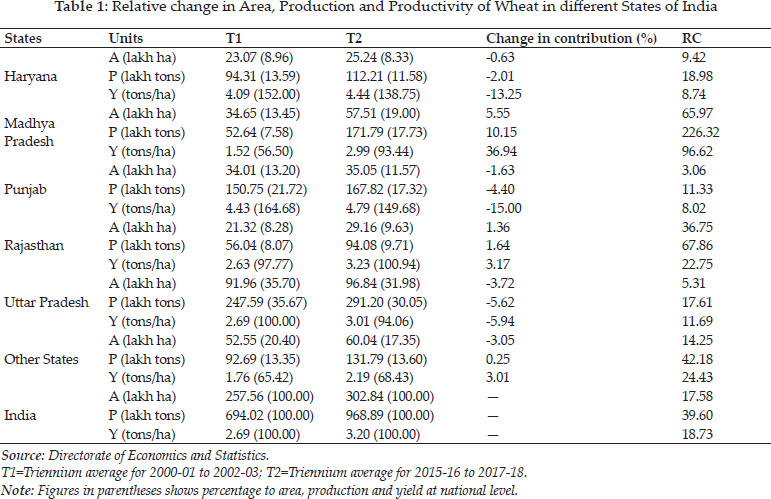
It is also noted from the above data that over the period of 18 years' time the contribution of increased area at national level mainly accounted for Madhya Pradesh (5.55%) followed by Rajasthan (1.36%). On the contrary the share of wheat area to national area of wheat in T2 period is declining in major wheat producing states, it is decreasing by 3.72 per cent in Uttar Pradesh and by 1.63 per cent in Punjab. Similarly, the increase in production of wheat in T2 period over T1 period is mainly contributed by Madhya Pradesh (10.15%) on account of increase share of productivity by 36.94 per cent although the average productivity of wheat during T2 period (2.99 tons/ha) is still below the national average of 3.20 tons per ha exhibiting that there is still scope for increasing of wheat production in Madhya Pradesh.
Production Variability and Growth
The data presented in table 2 indicated variability and growth in production components in major wheat producing states of India.
The variability of wheat crop in India for area, production and productivity was 6.81, 13.87 and 8.10 per cent, respectively. The highest variability in area is noted for Madhya Pradesh (20.43%), followed by Rajasthan (16.45%) and other states (7.88%) and lowest variability was noted for Punjab (1.26%), Uttar Pradesh (3.12%) and Haryana (4.33%). The highest variability in production is noted for Madhya Pradesh (47.1%), followed by Rajasthan (21.67%) and others (16.45%) and lowest variability was noted for Punjab (7.05%), followed by Haryana (10.53%) and Uttar Pradesh (11.11%). Whereas the highest variability in productivity is noted for Madhya Pradesh (26.73%) and it is lowest for Punjab (6.37%) states. This revealed that this crop is well established in the cropping pattern of Punjab, Uttar Pradesh and Haryana due to assured irrigation supply during Rabi season through canals and tube wells. On the other hand, in Madhya Pradesh and Rajasthan the area allocation to this crop mainly depends on monsoon rains.
It is also indicated that over the year area, production and productivity for wheat in India has been increased with positive and highly significant compound growth rate of 1.21, 2.46 and 1.23 per cent, respectively. Madhya Pradesh is showing maximum positive and highly significant compound growth rate of area, production and productivity by3.49, 8.21 and 4.56 per cent, respectively. The compound growth rate of area was positive and highly significant for Haryana (0.69%), Punjab (0.18%), Rajasthan (2.59%), Uttar Pradesh (0.49%) and other states were also showing positive and significant CGR (0.85%). The positive and highly significant compound growth rate of production was observed in Haryana (1.5%), Madhya Pradesh (8.21%), Punjab (0.91%), Rajasthan (3.92%), Uttar Pradesh (1.19%) and others (2.6%). Haryana showed positive and significant compound growth rate of productivity with 0.8 per cent whereas Madhya Pradesh, Punjab, Rajasthan and others indicated positive and highly significant compound growth rate with 4.56, 0.72, 1.29 and 1.74 per cent. Uttar Pradesh depicted positive but non-significant growth rate of productivity (0.69%). The highest growth in area, production and productivity of wheat in Madhya Pradesh helps in confirming Krishi Karman Award for last five consecutive years. The similar results were reported by Mishra et al. (2014) and Nahatkar & Rajan, (2015).

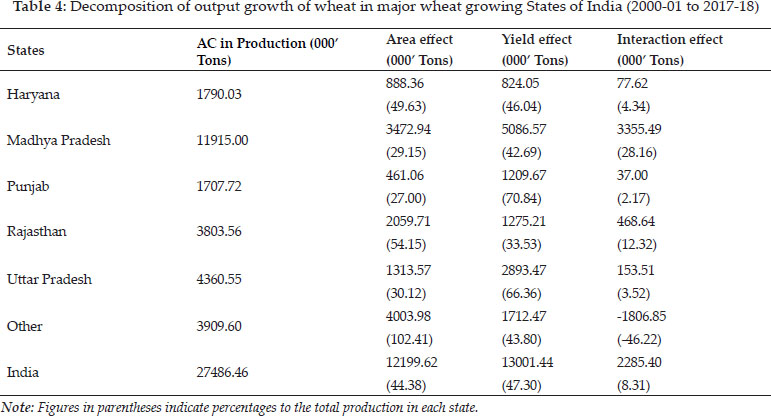
Decomposition analysis
For estimating the contribution of area and yield towards increase/decrease in production of wheat the simple decomposition model was used in which contribution of productivity is the part of production due to increased wheat acreage over the base year productivity. The contribution of interaction is the part of production due to increased yield in the increased wheat acreage. The analysed data for different states are presented in table 3. It is observed from the data that yield contributed positively in increasing the production of wheat and its effect on total wheat production in the India was 47.3 per cent followed by area effect (44.38%). The contribution of interaction effect towards increased wheat production was only 8.31 per cent showing that over the period the increased productivity of wheat contributed more as compared to increase in area and their interactions.
The contribution of area was highest in other states (102.41%), Rajasthan (54.15%) and Haryana states (49.63%). On the contrary the yield effect was highest in Punjab (70.84%), Uttar Pradesh (66.36%), Madhya Pradesh (42.69%) and for country as a whole (47.30%). The interaction effect was highest in Madhya Pradesh (28.16%) as compared to other major wheat producing states. The highest relative change in production was also noted for Madhya Pradesh (11915.00 th tons) and only enhance yield over the years increased production by 5086.57 th tons.
CONCLUSION
The analysis of variability and growth in production components of wheat in India and major wheat producing states leads to conclude that the variability in area, production and yield was lower in states where this crop is well established in the cropping pattern on account of development of assured irrigation infrastructure facilities of canals and tube wells. The highest growth rates in area, production and productivity of wheat for Madhya Pradesh shows that this state is emerging as food bowl of India on account of increased productivity and area due to assured electricity supply for using available irrigation potentials. Therefore, it is recommended that the varieties suited to irrigated ecosystem of wheat production along with matching production technologies should be promoted to tap the available potential for quality wheat production in central part of India.
REFERENCES
Agam, P.A., Tale, S.G. and Thakare, S.S. 2017. Economics of Wheat Production. International Research Journal of Agricultural Economics and Statistics, 8(1): 1-7.
Ahirwar, R.F., Verma, A.K. and Shekhawat, L.S. 2015. Cost and Income Structure of Wheat Cultivation in Vindhyan Plateau of Madhya Pradesh. Economic Affairs, 60(1): 83-88.
Mishra, P.K., Nahatkar, S.B. and Mishra, S. 2014. Dynamics of Wheat Production in Madhya Pradesh. In: Recent Trends on Production Strategies of Wheat in India (Eds Shukla, RS., Mishra, PC., Chatrath, R., Gupta, RK., Tomar, SS. and Sharma, I.), J.N.K.V.V. Jabalpur & Indian Institute of Wheat & Barley Research (ICAR) Karnal 2014, pp. 290-296.
Nahatkar, S.B.R. and Rajan, P. 2015. Irrigation Induced Growth of Wheat Production in different Agro-climatic Zones of Madhya Pradesh. Indian Journal of Agricultural Economics, 70(3): 392-393.
Tripathi, A. and Mishra, A.K. 2017. The Wheat Sector in India: Production, Policies and Food Security; pp. 275-296. URL: https://www.researchgate.net/publication/309019762.
Yadav, H., Singh, S.K., Singh, G.P. and Singh, K.K. 2014. An Economics Analysis of Wheat Cultivation in Etawah districts of Uttar Pradesh, India. Plant Archives, 14(1): 393-399.
Directorate of Economics and Statistics, Department of Agriculture, Cooperation and Farmers Welfare, Ministry of Agriculture and Farmers Welfare, Government of India, New Delhi, https://eands.dacnet.nic.in/APY_96_To_07.htm
Food and Agriculture Organization of the United Nations, http://www.fao.org/faostat/en/#data/QC